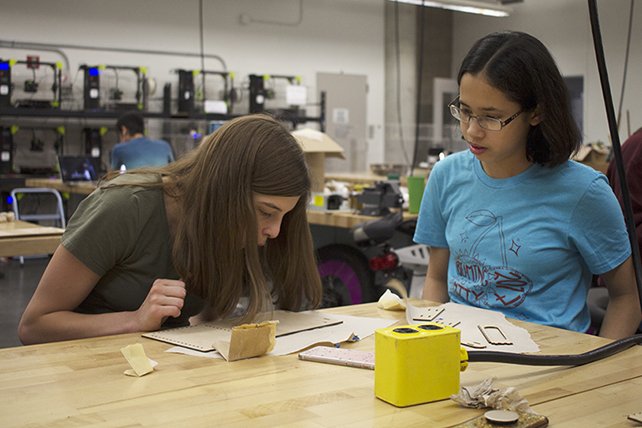Cracking the code

Camp helps increase pipeline for more diverse computer scientists
September 10, 2018
This past summer, it wasn’t unusual to walk through campus and hear chirping. But it wasn’t the sounds of birds outside. It was the mechanical beeping of robots in the basement of Lind Hall.
The Lind Hall computer lab was full of chirping robots, 32 tiny black domes skittering around on gray tables, and 32 female junior high and high school students listening intently to computer science instructor Shana Watters as she explained how to make the robots do the “tornado.”
Each girl had a white sheet of paper, with straight lines drawn in blue, green, and red. To anyone else, the colors meant nothing, but to these girls, different combinations of colors correspond to a program within the robot that commands it to move slowly, quickly or spin around in a circle (the aforementioned “tornado”).
Welcome to ‘fun school’
Robot programming was just one example of activities at Computer Science and Engineering Professor Maria Gini’s summer computer programming academy for young female students. The programming camp, or as the girls like to call it, “fun school,” consisted of two camps, the first lasting two weeks and aimed at girls with prior computer programming experience, and the second lasting one week for girls with no prior experience.
This is the fourth consecutive year of the camp, which Gini started in 2015 with the goal to bring more women into the computer science field. The first two years of the camp were funded by an anonymous donor who wished to kickstart a program that would keep young women interested in computer science down the line.
And if the students’ excitement is any indication, “fun school” is certainly broadening their interest in science and technology.
Opening up endless possibilities
Many of the girls enjoy the endless possibilities and creative opportunities that computer programming provides.
“I think it’s fun to be able to portray whatever you want,” said 16-year-old Amy Wang from Edina. “It’s pretty amazing how much you can do with the program.”
Others added that the camp gives a feeling of accomplishment.
“It feels amazing. Like hey, I made this,” said Arya Lucht, age 16 from Arden Hills.
Over a span of two weeks, these students learned the basics of Python code, animated a virtual Pac Man and designed and assembled foldable wooden boxes using the laser cutter in Anderson Labs. And that’s not even the tip of the iceberg. Other activities included learning image processing, 3D printing designs, programming online quizzes and making drawings move using Sketchpad.
An overwhelming favorite was a trip to the Virtual Reality Lab, in which the students, led by Computer Science and Engineering Professor Victoria Interrante, were able to experiment with VR goggles.
Planning for the future
While the students range from grades 6-12, many of them are already thinking about the future benefits of their experience at the camp. Stuti Arora, a 16-year-old student from Maple Grove, is involved programming on her high school FIRST robotics team, but she wants to learn more.
“I try to grab any opportunity that will teach me how to program more and use more applications of it rather than just programming a robot for competition,” Arora said.
“I guess computer science is a pretty relevant skill to have now, since you can have a lot of jobs with it,” Wang added. “So, I think it’s important to know for the future also.”
Professor Gini herself expressed how impressed she is with the campers and how serious they are about learning, explaining that many students arrive early in the morning and read their programming textbooks without being told.
“They all want to be here, and they are all working very hard,” Gini said. “It’s a pleasure to have these kinds of girls.”
Gini said last year, about 20 percent of the computer science majors at the University of Minnesota were women. Although she agreed that this number wasn’t bad, it wasn’t good either, and she wants to increase that percentage.
“Companies need women,” Gini said. “When you design things, you kind of design what you think would be useful to you, so if there are no women, a lot of things would not get designed.”
Gini explained that an important part of expanding the pipeline of women engineers is inspiring confidence in young girls. This is something that, by the end of the computer science academy, Gini’s students clearly demonstrate.
During the last few days of the program, each camper must come up with a creative project that incorporates programming, whether it be reverting colors in pictures, creating mosaic designs or 3D printing. Gini said that last year, a couple of her students designed an LED T-shirt meant to be worn by cyclists at night.
“They are more confident because there’s one thing they’ve done on their own, and they’re proud to show it,” Gini said.
Gini added that some of her former campers have gone on to win technology awards at their high schools or even decided to pursue computer engineering at the University of Minnesota.
Not to be outdone, this year’s group of students have some pretty big dreams as well. A few future applications the girls cited included architectural design, prosthetic limbs and— a long shot, but a dream nonetheless— teleportation devices.
Story by Olivia Hultgren and video by Marcos Hernandez
If you’d like to support summer camps or other K-12 outreach programs, visit our CSE giving page.
